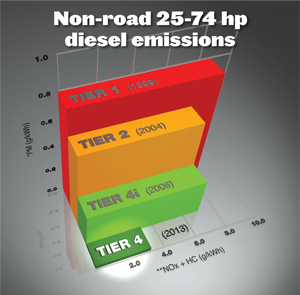
All US regulated emission standards, including Tier 4, are extensions of the “Clean Air Act” (1963) which was enacted to reduce air pollution. The Environmental Protection Agency (EPA), which is the Federal organisation responsible for managing and regulating the Clean Air Act, put forward a multi-year plan in the mid 1990’s with “tiered” mandates to reduce the level of harmful emissions such as particulate matter (PM) and Nitrogen Oxides (NOx) that enter the air via diesel engine exhaust. The “final” and most technologically challenging implementation stage, whereby engine and turf equipment manufacturers are required to produce products that comply with these most stringent emission reductions, is called “Tier 4”. The Tier 4 emission standard will reduce already-reduced emissions of PM by 90%. To give you a sense of how stringent the Tier 4 standard is, consider the fact that in many parts of the United States, the air leaving Tier 4-compliant machines will actually be cleaner than the incoming air!

The EPA Tier 4 specification was first applied to industries with large on-road vehicles (such as semi trailers and other diesel-powered trucks) and followed shortly thereafter by large off-road equipment categories (such as agricultural and construction equipment). In each case, vehicles or equipment with diesel engines greater than 55.9 kilowatt (kW)/75 horsepower (hp) were required to comply by specified dates. In the Turf Industry, most of the commercially available diesel-powered products are in the 18.6 to 55.2 kW (25 to 74 hp) range and the Tier 4 mandate requires compliance for any products produced in this kilowatt (horsepower)/performance category.